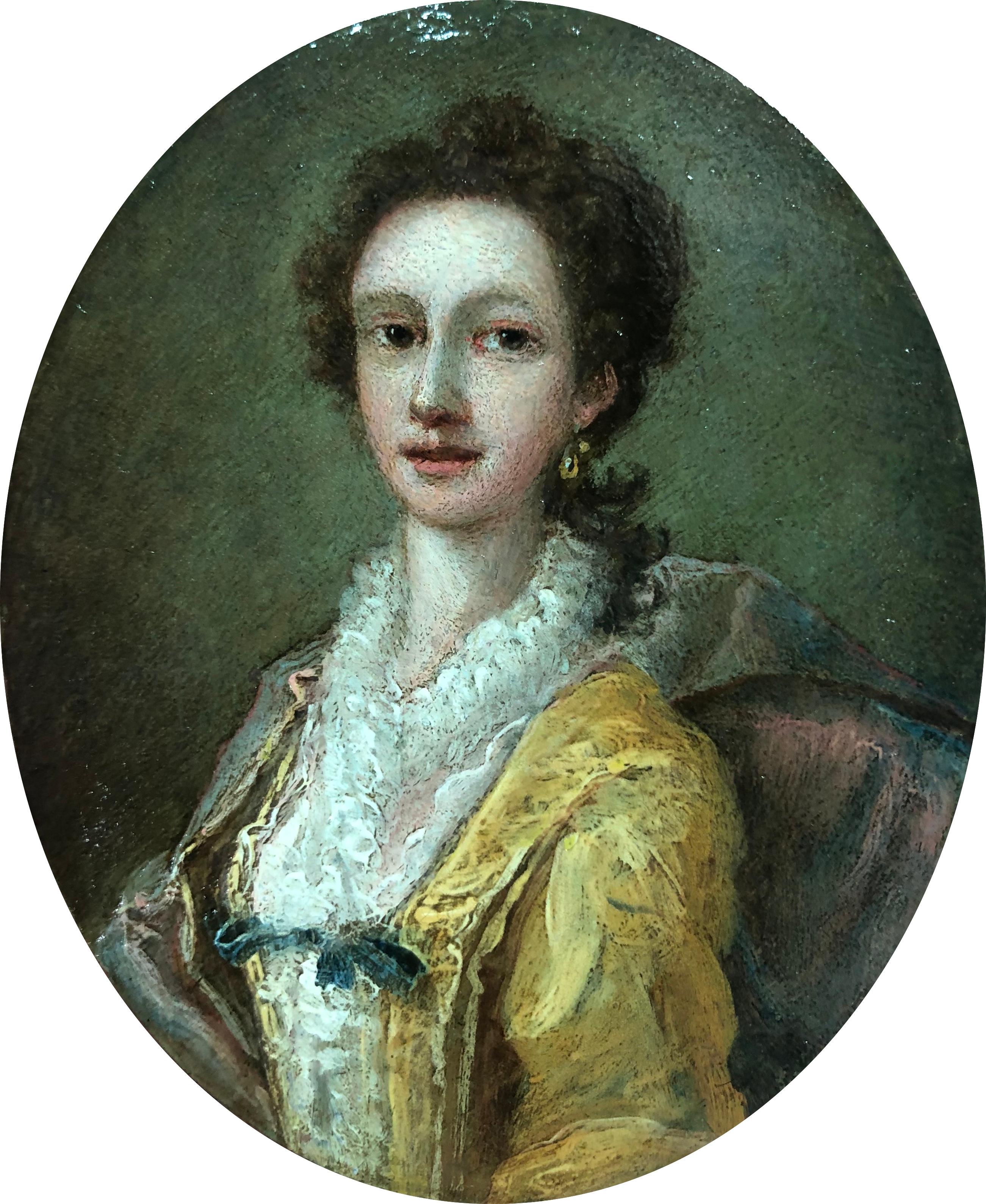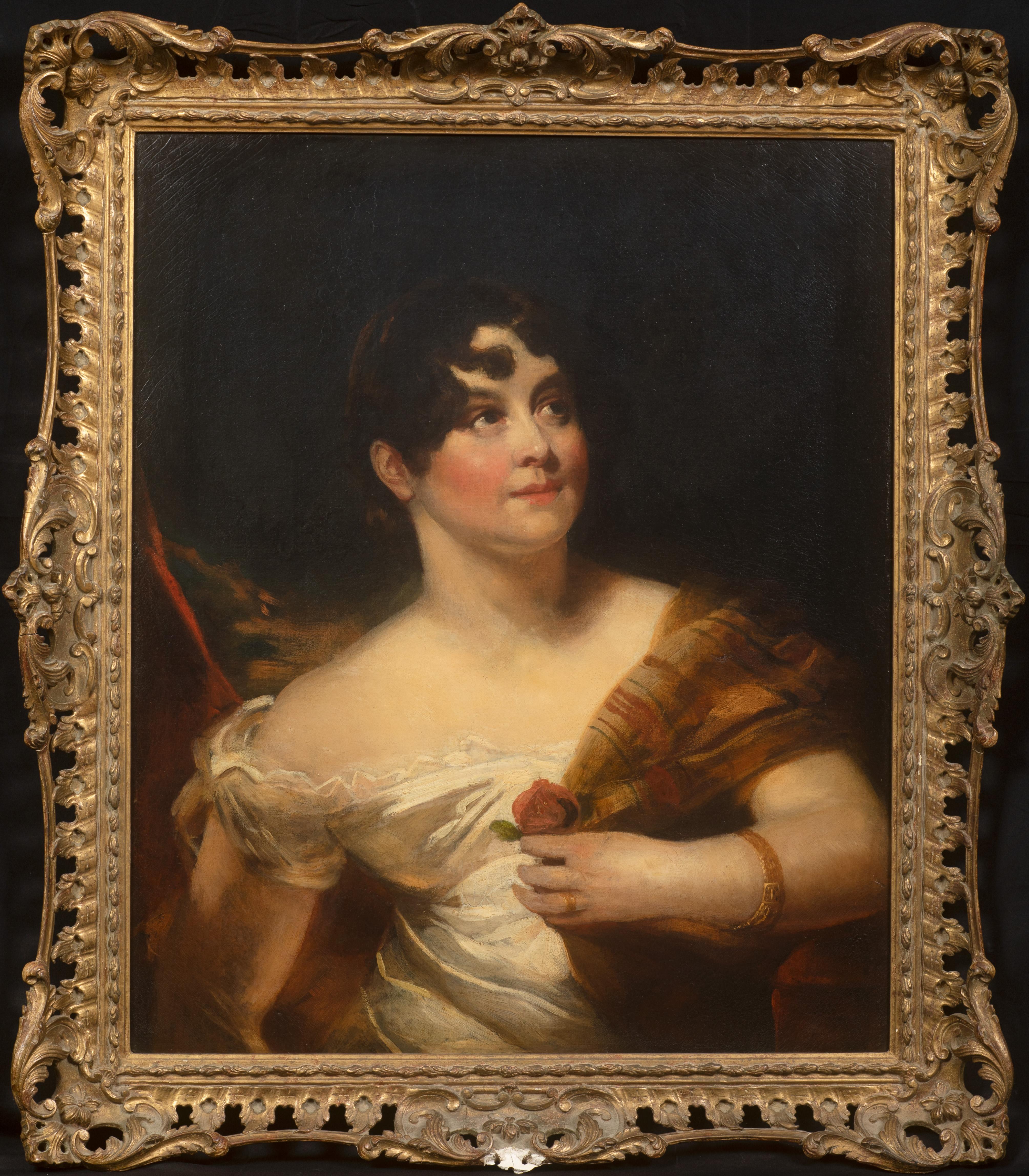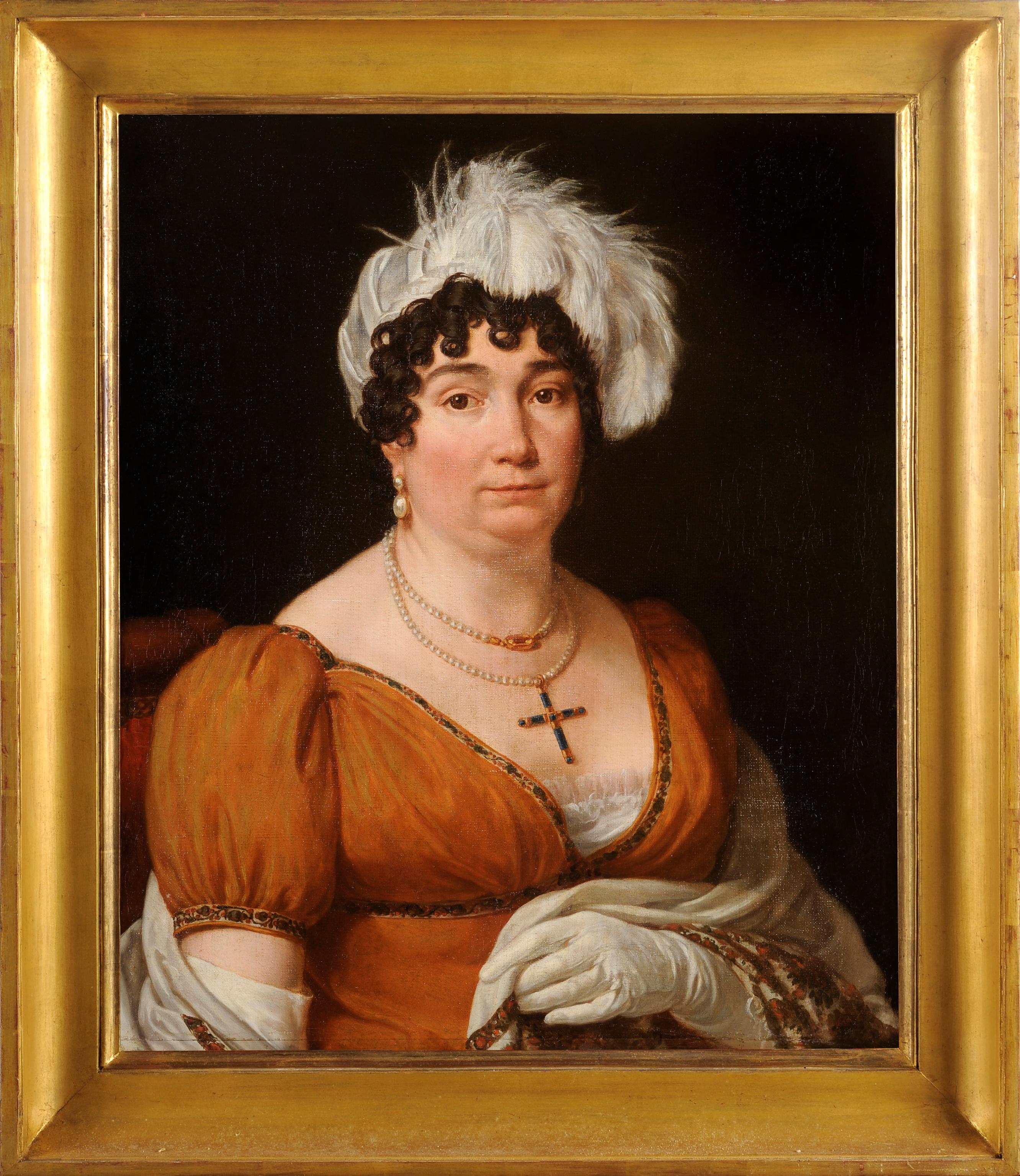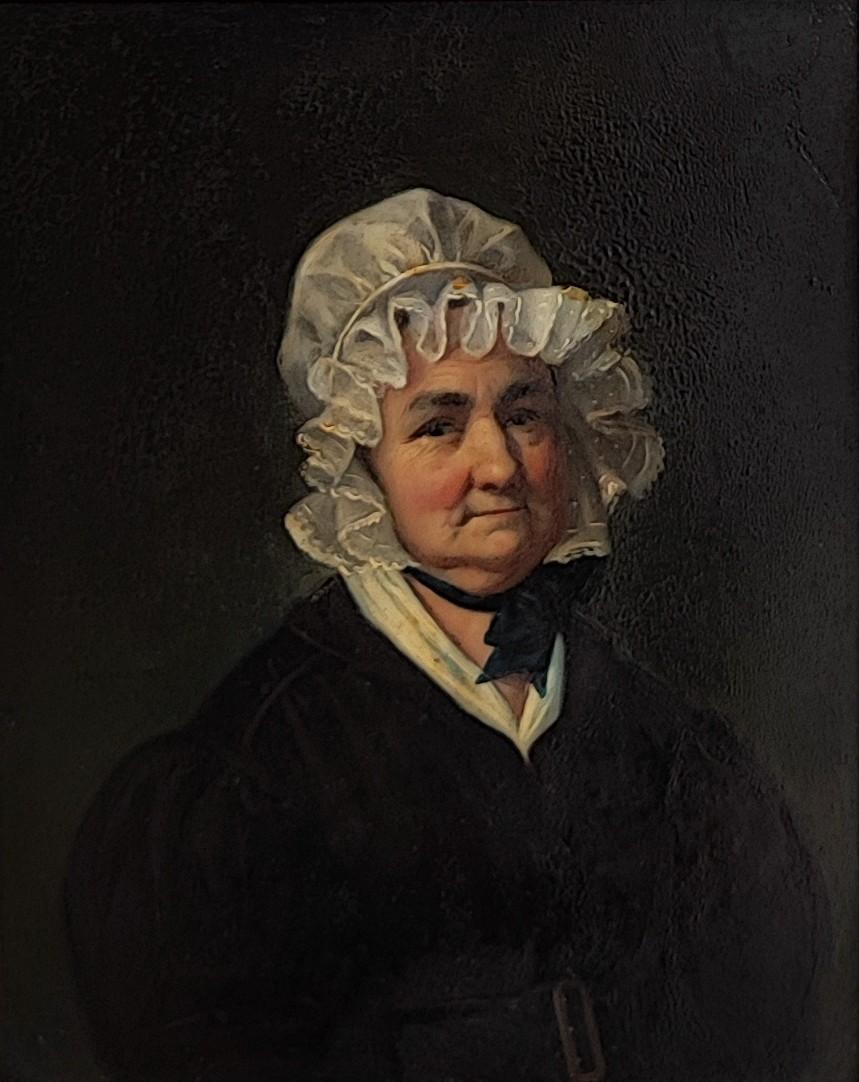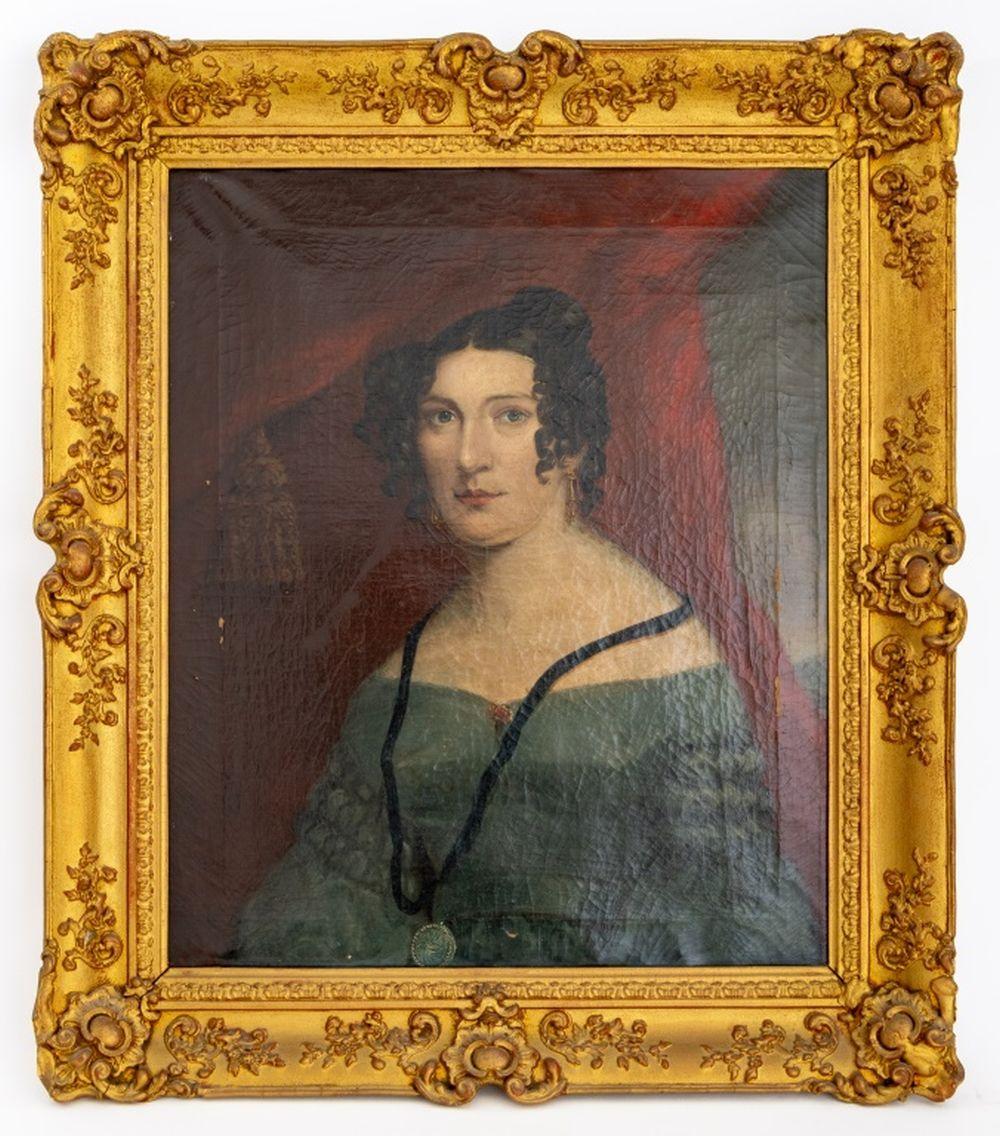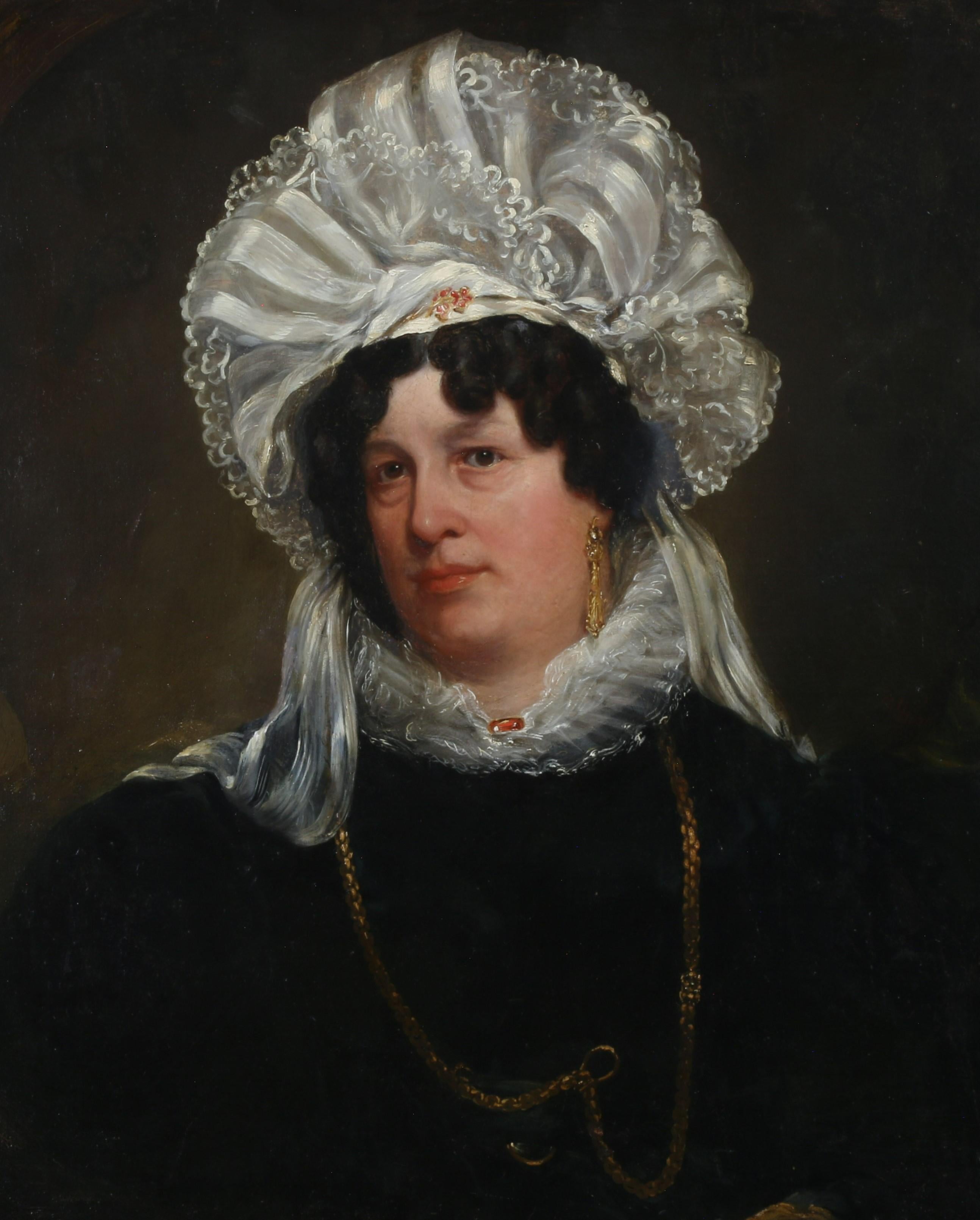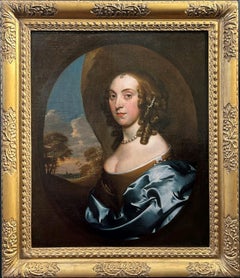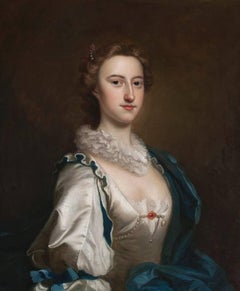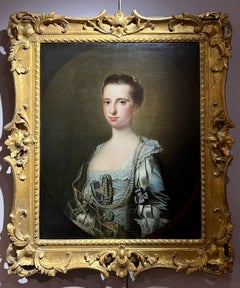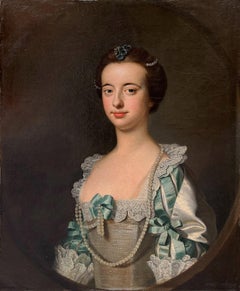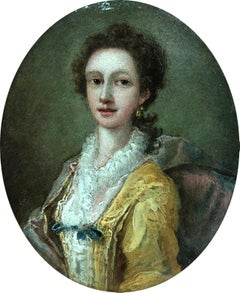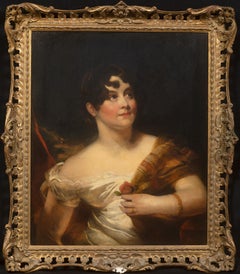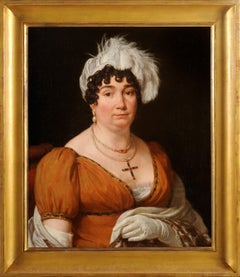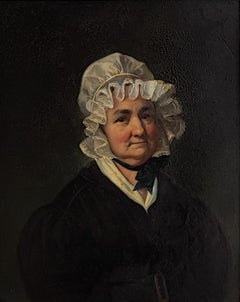Want more images or videos?
Request additional images or videos from the seller
1 of 7
Portrait of Lady
$19,612.16
£14,400
€16,875.03
CA$27,491.35
A$30,289.06
CHF 15,679.45
MX$364,688.17
NOK 198,539.81
SEK 186,515.59
DKK 126,004.23
About the Item
John Westbrooke Chandler
1763- 1807
Oil on canvas
Image size: 30 x 25 inches (76 x 63.5 cm)
Original gilt swept frame
This portrait is marked by its loose brushwork, which creates a sense of hazy nostalgia. Despite the loose strokes, the level of detail in this portrait is readily apparent. The sitter’s cheeks are bright and rosy, and the smile that plays on her lips also causes her eyes to crease slightly. Her soft curls, rendered in brown and auburn tones, are styled with a headband that pulls her hair away from her face and lets it cascade down her shoulders. The lady wears a yellow dress with gold trims reminiscent of Classical Greek clothing, with the folds and texture of the dress beautifully rendered by the artist. There is an elegance to the sitter, as well as a sense of playfulness and joy.
John Westbrooke Chandler
Born in 1763, John Westbrooke Chandler was the illegitimate son of George Greville, 2nd Earl of Warwick. At the age of 21, he joined the Royal Academy School and exhibited many his his portraits at the Royal Academy shows. His natural father was a keen patron of his, and allowed him to utilise rooms at Warwick Castle for his studios.
In 1800, he moved to Scotland, settling first in Aberdeenshire and then Edinburgh. He completed many portraits in Scotland, as well as the ballad ‘Sir Hubert’, but was also have known to become increasingly depressed and melancholic during his time in the country, during which he allegedly attempted suicide. This sparked the false claim that Chandler had died in a mental institution - instead, he moved to Stroud in Gloucestershire, and continued painting portraits for patrons in that area until his death in 1807.
Chandler’s works influenced many of the leading portraitists of his time, including John Hoppner, Thomas Lawrence, and Joshua Reynolds.
- Attributed to:John Westbrooke Chandler (1763 - 1807, British)
- Dimensions:Height: 30 in (76.2 cm)Width: 25 in (63.5 cm)
- More Editions & Sizes:1 of 1Price: $19,612
- Medium:
- Movement & Style:
- Period:
- Condition:
- Gallery Location:London, GB
- Reference Number:1stDibs: LU52416152492
About the Seller
5.0
Vetted Professional Seller
Every seller passes strict standards for authenticity and reliability
Established in 2007
1stDibs seller since 2014
85 sales on 1stDibs
Typical response time: 2 hours
- ShippingRetrieving quote...Shipping from: London, United Kingdom
- Return Policy
Authenticity Guarantee
In the unlikely event there’s an issue with an item’s authenticity, contact us within 1 year for a full refund. DetailsMoney-Back Guarantee
If your item is not as described, is damaged in transit, or does not arrive, contact us within 7 days for a full refund. Details24-Hour Cancellation
You have a 24-hour grace period in which to reconsider your purchase, with no questions asked.Vetted Professional Sellers
Our world-class sellers must adhere to strict standards for service and quality, maintaining the integrity of our listings.Price-Match Guarantee
If you find that a seller listed the same item for a lower price elsewhere, we’ll match it.Trusted Global Delivery
Our best-in-class carrier network provides specialized shipping options worldwide, including custom delivery.More From This Seller
View AllPortrait of a Lady
Located in London, GB
Gilbert Soest
1605-1681
Portrait of a Lady
Oil on canvas
Image size: 30 x 25 inches (76.2 x 63.5 cm)
Original carved gilt frame
Provenance
Private Estate, England
This portrait dep...
Category
17th Century Portrait Paintings
Materials
Oil, Canvas
Portrait of a Lady, Old Masters 18th Century Oil
By Thomas Hudson
Located in London, GB
Thomas Hudson
1701 – 1779
Portrait of a Lady
Oil on canvas
Image size: 30 x 25 inches
Original carved giltwood frame
Hudson had many assistants, and employed the specialist drapery ...
Category
18th Century Old Masters Portrait Paintings
Materials
Canvas, Oil
Portrait of Lady Mansfield of Ringwood
By Thomas Hudson
Located in London, GB
Portrait of Lady Mansfield of Ringwood
Oil on Canvas, unsigned
Image size: 25 x 30 inches (63 x 76 cm)
Original carved & gilded frame
Provenance
Descended through the Family Estate
...
Category
18th Century English School Paintings
Materials
Canvas, Oil
Portrait of Lady Mansfield of Ringwood
By Thomas Hudson
Located in London, GB
Portrait of Lady Mansfield of Ringwood
Oil on Canvas, unsigned
Image size: 25 x 30 inches (63 x 76 cm)
Original carved & gilded frame
Provenance
Descended through the Family Estate
Born in Poland in 1760 to the 2nd Earl of Mansfield and his wife, Elizabeth Mary Murray would later come under the care of her uncle, William Murray (1st Earl of Mansfield) at Kenwood House in Hampstead. David Murray (2nd Earl of Mansfield) was set to inherit the title and full wealth of his uncle, including Kenwood House. Lady Mansfield’s second cousin would soon join her at Kenwood, where they would be raised together and featured in multiple portraits of the time. Her younger sister, Henrietta, is seen in a separate portrait done by Thomas Hudson as well. At the age of 25 she married George Finch-Hatton, an English aristocrat and politician who sat in the House of Commons from 1772-1784.
Gazing out at the viewer, Lady Mansfield wears a decorated dress, with an abundance of pearls and lace, and a transparent gold lined veil surrounding her right shoulder. The excess of luxurious fabric matches another Hudson portrait of another Lady Mansfield, with the lace detailing and complementary bodice. The depiction of this Lady Mansfield epitomizes the style of portraiture in the 18th century, such as the styles Hudson’s pupils Joshua Reynolds, Joseph Wright, and Peter Toms. From Hudson’s travels to the Low Countries and Italy, he no doubt brought back artistic inspiration from the international pieces he encountered.
Thomas Hudson
Hudson was a celebrated 18th century portrait painter. Born in Devon in 1701 he studied under the artist Jonathan Richardson and married his daughter, against Richardson’s wishes.
He had many artistic friends including William Hogarth and Francis Hayman and travelled with them in Europe in 1748. He also visited Italy with the sculptor Louis-François Roubiliac in 1752. Hudson’s style of portraiture proved so successful that for a decade from 1745 to 1755 he was London’s most popular portrait painter and made a fortune painting the cream of London society and members of the Royal Family.
He was also a talented teacher, perhaps too good, as subsequently a number of his former assistants overtook him in popularity including the artist Joshua Reynolds.
Hudson retired in the late 1750’s and died in Twickenham in 1779. His most notable works include portraits of King George II and George Friedrich Handel and his “Portrait of a Nobleman in Van Dyck dress.” Many of Hudson’s works may be seen in art galleries. These include the National Portrait Gallery, the National Maritime Museum, the Tate Gallery, the Foundling Museum and the Bristol City Museum and Art Gallery. His works are also in Museums across the world...
Category
18th Century English School Paintings
Materials
Canvas, Oil
Portrait of Ann Austen, nee Grey
By Bartholomew Dandridge
Located in London, GB
Signed 'BDandridge/ pinxit' lower left
Provenance
By descent through the sitter's family to
The Collection of R. W. Vivian-Neal of Poundisford Park, Somerset, from whom acquired by
With Lane Fine Art, UK, where purchased by the present owners in 1996
Literature
'Poundisford Park, Somerset' in Country Life, 22 December 1934, ill.
A.W. and C.M. Vivian-Neal, Poundisford Park, Somerset: A catalogue of pictures and furniture, Taunton 1939, cat. nos. 11 and 13
This is a portrait of Ann Austen, nee Grey, three-quarter-length seated in a landscape with her dog. Painted in a superb white satin dress, she holds horn spectacles and a spectacle case...
Category
Mid-18th Century English School Portrait Paintings
Materials
Oil
Portrait of a Lady, Early 20th Century Oil
By Arthur Ambrose McEvoy
Located in London, GB
Follower of Ambrose McEvoy (unsigned)
Circa 1910
Portrait of a Lady
Oil on canvas
Image size: 20 x 16 inches (51 x 40.5 cm)
Original ebonised Frame
A stunning portrait of a lady ...
Category
Early 20th Century Portrait Paintings
Materials
Oil, Canvas
You May Also Like
Portrait of a Lady
By Francesco Guardi
Located in Paris, Île-de-France
Francesco GUARDI (1712-1793)
Portrait of a Lady
Oil on copper
5 1/8 x 4 3/8 in
13 x 11 cm
Unsigned
Provenance
Private collection, France
We are pleased to present an exceptional...
Category
Mid-18th Century Old Masters Portrait Paintings
Materials
Copper
Portrait Of A Lady, 19th Century
By Sir Thomas Lawrence
Located in Blackwater, GB
Portrait Of A Lady, 19th Century
circle of Sir Thomas LAWRENCE (1769-1830)
Fine large early 19th Century portrait of a young lady, oil on canvas. Super quality and condition study ...
Category
19th Century Portrait Paintings
Materials
Canvas, Oil
$4,249 Sale Price
36% Off
Portrait of Madame Leblond
Located in BELEYMAS, FR
French school circa 1815
Portrait of Madame Leblond
Oil on canvas
H. 66 cm; W. 55 cm
Named on the back
Comparable to the works of painters such as Louis Hersent, our portrait, unsig...
Category
1810s French School Figurative Paintings
Materials
Canvas, Oil
Woman
Located in Genève, GE
Work on wood
Plaster and gilded wood frame
47 x 40.5 x 6 cm
Category
Early 20th Century Old Masters Portrait Paintings
Materials
Oil
$2,204
Portrait of a Woman
Located in Astoria, NY
American School, Portrait of a Woman, Oil on Canvas, 19th century, unsigned, inscribed "J Harrison / 1836" to verso, giltwood frame. Image: 23"H x 19.25" W;...
Category
1830s American Realist Portrait Paintings
Materials
Canvas, Oil
Elizabeth Gordon Duchess of Gordon
By William Fisk
Located in Douglas, Isle of Man
William Fisk 1796 -1872, was an English born portrait and history painter. Although born in 1796 he didn't start his artistic career until after 1826, after the birth of his son Will...
Category
1830s Portrait Paintings
Materials
Canvas, Oil
